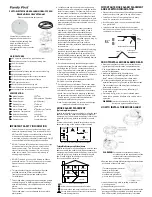
VESDA VLI Product Guide
VESDA by Xtralis
6
www.xtralis.com
2.2
How the VLI works
The VLI detector continually samples air from the protected environment via a sampling pipe network (A).
Upon entering the detector, the air passes four sets of ultrasonic flow sensors (B), then through the mixer
compartment of the Intelligent Filter (C), where it is split between two pathways. One pathway carries the
majority of the air through a HEPA filter, while the other carries a small proportion of the air through a separate
set of ultrasonic flow sensors (D). The air then recombines in the main aspirator (F).
A
B
D
E
F
G
H
J
K
L
M
I
N
C
Legend
A
Pipe Inlets
B
Ultrasonic Flow Sensors
C
Intelligent Filter
D
Ultrasonic Flow Sensor
E
Manifold
F
Main Aspirator
G
Sampling Probe
H
Secondary Foam Filter
I
Chamber Assembly
J
Chamber Flow Sensor
K
Chamber
L
Tertiary Clean Air Filter
M
Auto Zero Aspirator
N
Exhaust
Figure 2-2: Internal airflow example
Note:
The Intelligent Filter loading is constantly monitored using the ultrasonic flow sensors in the
unfiltered path (D). Coupled with the arrangement of the four sets of ultrasonic flow sensors at the
detector air inlets (B), the detector measures the split of the airflow ratio as the filter loading
increases. The detector maintains the sensitivity depending on the flow ratio, thus ensuring
consistent and reliable operation over time.
A portion of recombined air sample is then passed through the sub-sampling probe (inertial separator) and
secondary foam filter (H). Larger dust particles are unable pass through the probe and filter arrangement and
hence are exhausted out of the detector (N). This eliminates nuisance alarms caused by larger dust particles
and extends the life of the detection chamber (K). The tertiary clean air filter (L) provides clean air to form the
clean air barriers within the detection chamber (K), which protects the optical surfaces from contamination.
The presence of smoke in the detection chamber (K) creates light scattering which is detected by the sensor
circuitry. The air sample is measured, and the detector reports smoke levels in line with the sensitivity ratio
determined by the Flow Sensors (B and D). Air is exhausted from the detector and may be vented back into
the protected area (N).
Note:
The status of the detector, all alarms, service and fault events, are monitored and logged with time
and date stamps. Status reporting can be transmitted via relay outputs, across VESDAnet
(VESDAnet version only) or BACnet.
Содержание VESDA VLI
Страница 1: ...VESDA VLI Product Guide June 2012 Document 18500_A2 Part Number 29674 ...
Страница 2: ......
Страница 56: ...VESDA VLI Product Guide VESDA by Xtralis 50 www xtralis com This page is intentionally left blank ...
Страница 82: ...VESDA VLI Product Guide VESDA by Xtralis 76 www xtralis com This page is intentionally left blank ...













































